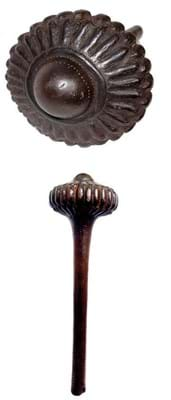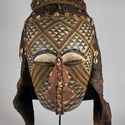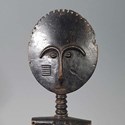According to legend, the mask was invented by first-century queen Ngokady, regent during her son’s minority, to represent women and recall their cultural and political contributions. The example in question has characteristic decorations, such as the lines under the eyes for tears (representing hardship) and a raffia strip of beadwork covering the mouth to represent silence. The colours include white for mourning, red for suffering and blue for status.
It also embodies the sister of the founding hero, Woot. In ritual re-enactments of mythical episodes, the ngaady a mwaash is worn by a man, as is the mushambooy (representing Woot) and bwoon (spirits and pygmies). Scenes performed include the ritual incest fundamental to the perpetuation of the dynasty, and reinforcing the importance of women in political life.
Brought to TAL by dealer Philip Keith, the mask is offered for £12,000. “What is nice about this example is that it has retained its colour and raffia headdress,” Keith says. It was collected in 1920, probably shortly after it was made, and brought back to the UK, meaning that, unlike examples stored in the rafters of tribal homes, it was not subject to gnawing from insects or rats. “It’s not often that African masks depict women. They’re normally of spirits or male ancestors, but all the smaller kingdoms within Kuba society have a version of this, all conforming to the same form. It reinforces the power of women in Kuba culture.”
Makers and users
Mother, Muse and Maker, the theme of this 12th staging of the London fair, explores the role of women as inspiration for makers and users of tribal art, as well as its buyers and sellers. TAL takes place at the Mall Galleries from September 4-7, hosting more than 20 international dealers in African, Oceanic and South American works which are offered for prices ranging from the low hundreds of pounds to more than £20,000.

Late-19th century Yombe figure offered by David Malik at Tribal Art London for £24,000. Made of wood in what is now Democratic Republic of Congo.
Other highlights fitting the theme include a Yombe Mother figure from the late 19th century offered by David Malik and tapa cloth, made by Nelly Haruko Keme using the traditional techniques of her female Polynesian ancestors, on the stand of Joss Graham.
Kezhia Orege, meanwhile, brings a mid-20th century Harari tribe basket from Ethiopia. The tribe is known for its basketry, incorporating complex traditional patterns and shapes. It would have been used as wall adornment, for presenting food on special occasions and as a gift to a bride’s mother-in-law.
Tours of the fair will focus on textiles by women and the role of adornment in tribal culture. For those wishing to delve deeper into the subject, a newly published book, Maternity: Mothers and Children in the Arts of Africa by Herbert M Cole, will be available from Charles Vernon-Hunt, a tribal art book specialist.
The event will also showcase the role of women in the UK’s tribal art trade through a series of interviews with female dealers and collectors about their experience in this male-dominated industry.
Alongside items devoted to the theme is the typical selection of other objects. For example, Marcus Raccanello offers an Ula ‘blooded’ Tavatava, or throwing weapon, used by Fijian warriors, which is offered for £3000, while Marcuson & Hall brings a rare wooden figural pipe bowl from the Philippines.




















